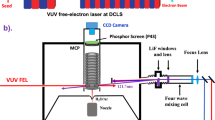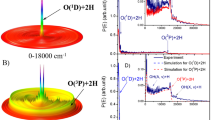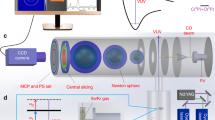Abstract
ONE of the main problems in atmospheric chemistry in recent years has been the discrepancy between theoretical model calculations of ozone concentrations and observations in the upper stratosphere and mesosphere1. It has been suggested2 that the photolysis of vibrationally excited oxygen could provide an extra source of ozone and new laboratory data now allow us to test this hypothesis in two ways. First, by including the proposed mechanism in a numerical model of the atmosphere, we find that the production of odd oxygen is enhanced and that the calculated ozone concentrations are significantly increased so that they agree well with observations. Second, we present a comparison between satellite observations of the daytime enhancement in the 6.9-μm emission from water vapour and theoretical calculations, which yields indirect evidence for the presence of vibrationally excited oxygen in the upper stratosphere and mesosphere; a significant fraction of which appears to be due to relaxation of very high vibrational levels. Both these tests demonstrate that the proposed mechanism may indeed account for most of the discrepancy between model results and observations.
This is a preview of subscription content, access via your institution
Access options
Subscribe to this journal
Receive 51 print issues and online access
$199.00 per year
only $3.90 per issue
Buy this article
- Purchase on Springer Link
- Instant access to full article PDF
Prices may be subject to local taxes which are calculated during checkout
Similar content being viewed by others
References
Atmos. Ozone Rep. No. 16 (World Meteorological Organisation, Geneva, 1986).
Slanger, T. G., Jusinski, L. E., Black, G. & Gadd, G. E. Science 241, 945–950 (1988).
Schmaizl, U. & Crutzen, P. J. Proc. Quad. Ozone Symp. (eds Zerefos, C. S. & Ghazi, A.) (Reidel, Dordrecht, 1984).
Jackman, C. H., Stolarski, R. S. & Kaye, J. A. J. geophys. Res. 91, 1103–1116 (1986).
Froidevaux, L., Allen, M., Berman, S. & Daughton, A. J. geophys. Res. 94, 6389–6417 (1989).
Natarajan, M. & Callis, L. B. Geophys. Res. Lett. 16, 473–476 (1989).
Rusch, D. W. & Eckman, R. S. J. geophys. Res. 90, 12991–12998 (1985).
Fairchild, C. E., Stone, E. J. & Lawrence, G. M. J. chem. Phys. 69, 3632–3638 (1978).
Sparks, R. K., Carlson, L. R., Shohatake, M. L., Kowalczyk, M. L. & Lee, Y. T. J. chem. Phys. 72, 1401–1402 (1980).
Kinugawa, T., Sato, T., Arikawa, T., Matsumi, Y. & Kawasaki, M. J. chem. Phys. 93, 3289–3294 (1990).
Fabian, P., Pyle, J. A. & Wells, R. J. J. geophys. Res. 87, 4981–5000 (1982).
Krupenie, P. H. J. Phys. Chem. Ref. Data 1 489–494 (1972).
Rapp, D. J. chem. Phys. 43, 316–317 (1965).
Deleon, R. L. & Rich, J. W. Chem. Phys. 107, 283–292 (1986).
Russell, J. M. et al. J. geophys. Res. 89, 5115–5124 (1984).
Kerridge, B. J. & Remsberg, E. E. J. geophys. Res. 94, 16323–16342 (1989).
Levene, H. B., Nieh, J. C. & Valentini, J. J. J. chem. Phys. 87, 2583–2593 (1987).
Thomas, R. G. & Thrush, B. A. Proc. R. Soc. Lond. A356, 307–314 (1977).
Valentini, J. J., Gerrity, D. P., Phillips, D. L., Nieh, J. C. & Tabor, K. D. J. chem. Phys. 86, 6745–6756 (1987).
Lopez-Puertas, M., Rodrigo, R., Molina, A. & Taylor, F. W. J. atmos. terr. Phys. 48, 749–764 (1986).
Solomon, S., Kiehl, J. T., Kerridge, B. J., Remsberg, E. E. & Russell, J. M. J. geophys. Res. 91, 9865–9876 (1986).
Taylor, R. L. Can J. Chem. 52, 1436–1451 (1974).
Author information
Authors and Affiliations
Rights and permissions
About this article
Cite this article
Toumi, R., Kerridge, B. & Pyle, J. Highly vibrationally excited oxygen as a potential source of ozone in the upper stratosphere and mesosphere. Nature 351, 217–219 (1991). https://doi.org/10.1038/351217a0
Received:
Accepted:
Issue Date:
DOI: https://doi.org/10.1038/351217a0
This article is cited by
-
Sensitivity of stratospheric composition to oxygen absorption of solar radiation (175?210 nm)
Journal of Atmospheric Chemistry (1994)
-
An evaluation of autocatalytic ozone production from vibrationally excited oxygen in the middle atmosphere
Journal of Atmospheric Chemistry (1992)
-
Diffuse radiation, twilight, and photochemistry ? I
Journal of Atmospheric Chemistry (1991)
Comments
By submitting a comment you agree to abide by our Terms and Community Guidelines. If you find something abusive or that does not comply with our terms or guidelines please flag it as inappropriate.



